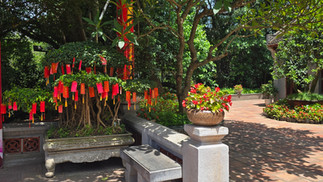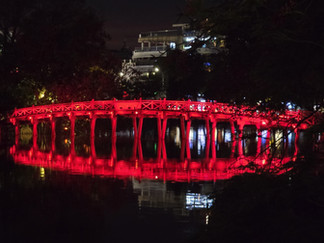Bridge Between Worlds - Ngọc Sơn Temple
- Shannon
- Jun 25
- 4 min read
Tucked away on a small jade-green islet in the heart of Hanoi’s Hoàn Kiếm Lake, Ngọc Sơn Temple (“Temple of the Jade Mountain”) is a portal into Vietnam’s tangled history of war, mysticism, and legend. Ngọc Sơn Temple rose in 1841 to honour the national hero General Trần Hưng Đạo, who crushed Mongol invaders in the 13th century, and its story is woven tightly with both fact and fascinating folklore. Beyond its veneration of Trần Hưng Đạo, the temple also pays homage to Nguyễn Văn Xương, a Taoist scholar revered for his wisdom, and Quan Vũ, a legendary Chinese general who embodies loyalty and righteousness, reflecting the deep fusion of Vietnamese, Taoist and Confucian traditions.

During the 15th century, Emperor Lê Lợi was gifted a divine golden sword by the Dragon King to drive out Ming invaders. After his victorious campaign and the liberation of Vietnam from Chinese rule, the emperor sailed across the lake but was stopped by a colossal golden turtle, an emissary of the gods. It rose from the depths and demanded the sword’s return. Lê Lợi had no choice but to surrender it, watching the sacred blade vanish beneath the ripples, returning to its divine guardians beneath the water. From that day on, the lake became known as Hoàn Kiếm, "the Lake of the Returned Sword". Some whisper that the turtle was no ordinary beast, but a spirit-warden and a reminder that human victories are always borrowed but never truly won.

In 1967, a massive soft-shell turtle was was seen gliding through the lake’s dark undercurrents. Affectionately called Cụ Rùa (“Grandfather Turtle”), he was thought to be over 200 years old. Sightings of him were often seen as auspicious and when he passed away in 2016, it was viewed by many as an ill omen, shadowing a period of political uncertainty in Vietnam. Cụ Rùa, his body heavy with the weight of centuries, was preserved and now rests inside a glass case within Ngoc Son Temple itself.

Inside the heart of Ngọc Sơn stands the grand altar dedicated to General Trần Hưng Đạo His statue, often depicted in full armour, is surrounded by offerings of incense, fruit and symbolic objects of war. Nearby, a second shrine honours Nguyễn Văn Xương, where students pray for success in their academic endeavours. His altar is decorated with scrolls, books and symbolic writing tools, reflecting Vietnam’s reverence for scholarship. Another key figure enshrined within the temple is Quan Vũ, legendary general from Chinese history celebrated for his loyalty and martial prowess.

His statue, usually shown wielding a large curved blade known as a guandao, receives offerings from those seeking protection, justice or business success. Tucked modestly within the complex is also an altar to La Tô Đại Vương, a folk spirit associated with healing and protection against disease. Although less grand than the other shrines, La Tô’s altar reflects the temple’s deeper connection to everyday hopes and fears. Alongside the altars and relics, visitors will find ceremonial swords, bronze bells, prayer scrolls and ancient stone steles inscribed with historical records.

The Thê Húc Bridge (translated as the "Morning Sunlight Bridge") is one of Hanoi’s most iconic landmarks, connecting the eastern shore of Hoàn Kiếm Lake to Ngọc Sơn Temple. The design of the 40 metre bridge follows traditional arch-shaped construction that’s meant to resemble the curvature of a dragon’s spine. This connection to the mythical dragon adds an extra layer of spiritual depth, implying that the bridge serves as a conduit between the human world and the sacred forces that are believed to dwell within the temple. The red colour of the famous bridge holds deep symbolic meaning in Vietnamese culture. Red is often associated with good fortune, prosperity and happiness. The name “Thê Húc” refers to the idea of sunlight breaking through the clouds, symbolising the arrival of hope and positive energy.

Location : Đinh Tiên Hoàng, Hàng Trống, Hoàn Kiếm, Hà Nội Old Quarter, Vietnam
How to get there : Ngọc Sơn Temple is right in the heart of the Old Quarter and is located on Jade Islet, on the northeast edge of Hoàn Kiếm Lake. Cross Thê Húc Bridge and you're there.
Attraction Info : The temple is open daily between 7am - 6pm on weekdays and 7am - 9pm on weekends. The entry fee is 300000VND for adults and 15000VND for students (children under 15 are free). The temple is open from 8am - 6pm daily. When visiting the temple, it is important to follow respectful etiquette to honour the sacred space. Visitors should dress modestly, covering shoulders and knees. When making offerings, do so gently and with sincerity. It is customary to bow slightly before the altar, whether or not you are actively participating in a ritual. Check before you take photos inside, as photography is often restricted near altars and sacred statues.

Thanks for reading Bridge Between Worlds - Ngọc Sơn Temple. Check more destinations here!





































